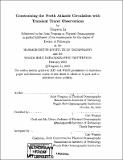| dc.contributor.advisor | Carl Wunsch. | en_US |
| dc.contributor.author | Li, Xingwen, 1968- | en_US |
| dc.contributor.other | Woods Hole Oceanographic Institution. | en_US |
| dc.date.accessioned | 2010-10-29T18:02:48Z | |
| dc.date.available | 2010-10-29T18:02:48Z | |
| dc.date.copyright | 2002 | en_US |
| dc.date.issued | 2003 | en_US |
| dc.identifier.uri | http://hdl.handle.net/1721.1/59652 | |
| dc.description | Thesis (Ph. D.)--Joint Program in Physical Oceanography (Massachusetts Institute of Technology, Dept. of Earth, Atmospheric, and Planetary Sciences, and the Woods Hole Oceanographic Institution), February 2003. | en_US |
| dc.description | Includes bibliographical references (p. 187-197). | en_US |
| dc.description.abstract | The capability of transient tracers to constrain the ocean circulation in the North Atlantic is explored. Study of an idealized tracer shows that inferences of circulation properties from transient state distributions are impacted by uncertainties in the time-varying boundary conditions and sparse data coverage. Comparison of CFC, tritium, temperature and salinity (T-S) observations with model results in the North Atlantic shows that regions of important model-data disagreements in the transient tracer fields can also be readily identified in the T-S distributions. In the model, excessive vertical penetration of convective adjustment, leads to problematic production and outflow of the NADW, again appearing in both transient tracer and T-S fields. Sensitivities of the model fields are determined using the adjoint model. In the dual solutions, CFC-11, CFC-11/CFC-12 ratio age, and T - (β/α)S (β and α are thermal and haline expansion coefficients, respectively) exhibit the major ventilation pathways and the associated timescales, in the model. High sensitivity fields are candidates for providing the most powerful constraints in the corresponding inverse problems. Assimilation of both CFC and tritium data, with different input histories, sampling distributions, and radioactive decay constants, shows that by adjusting only initial-boundary conditions of CFCs and tritium, a 1⁰ x 1⁰ offline model and the transient tracer data can be brought into near-consistency, in the domain between 4.5⁰S and 39.5⁰N of the North Atlantic. Constraining a GCM with transient tracers is thus fully practical. | en_US |
| dc.description.abstract | (cont.) However, the large uncertainties in the time-varying boundary conditions of transient tracer concentrations, and in their interior distributions, renders the transient tracers less-effective in determining the circulation than are more conventional steady tracers, and known oceanic dynamics. | en_US |
| dc.description.statementofresponsibility | by Xingwen Li. | en_US |
| dc.format.extent | 197 p. | en_US |
| dc.language.iso | eng | en_US |
| dc.publisher | Massachusetts Institute of Technology | en_US |
| dc.rights | M.I.T. theses are protected by
copyright. They may be viewed from this source for any purpose, but
reproduction or distribution in any format is prohibited without written
permission. See provided URL for inquiries about permission. | en_US |
| dc.rights.uri | http://dspace.mit.edu/handle/1721.1/7582 | en_US |
| dc.subject | Joint Program in Physical Oceanography. | en_US |
| dc.subject | Earth, Atmospheric, and Planetary Sciences. | en_US |
| dc.subject | Woods Hole Oceanographic Institution. | en_US |
| dc.title | Constraining North Atlantic circulation with transient tracer observations | en_US |
| dc.type | Thesis | en_US |
| dc.description.degree | Ph.D. | en_US |
| dc.contributor.department | Joint Program in Physical Oceanography | en_US |
| dc.contributor.department | Woods Hole Oceanographic Institution | en_US |
| dc.contributor.department | Massachusetts Institute of Technology. Department of Earth, Atmospheric, and Planetary Sciences | |
| dc.identifier.oclc | 52711660 | en_US |
